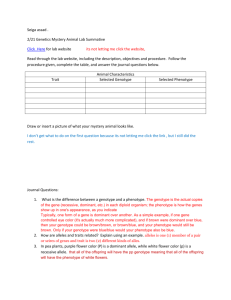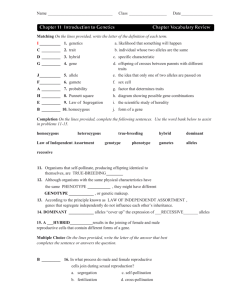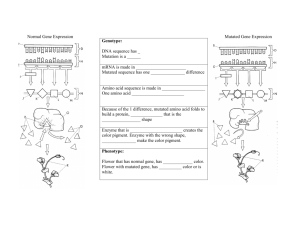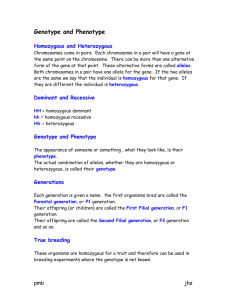Genetics - worksheet answers
advertisement
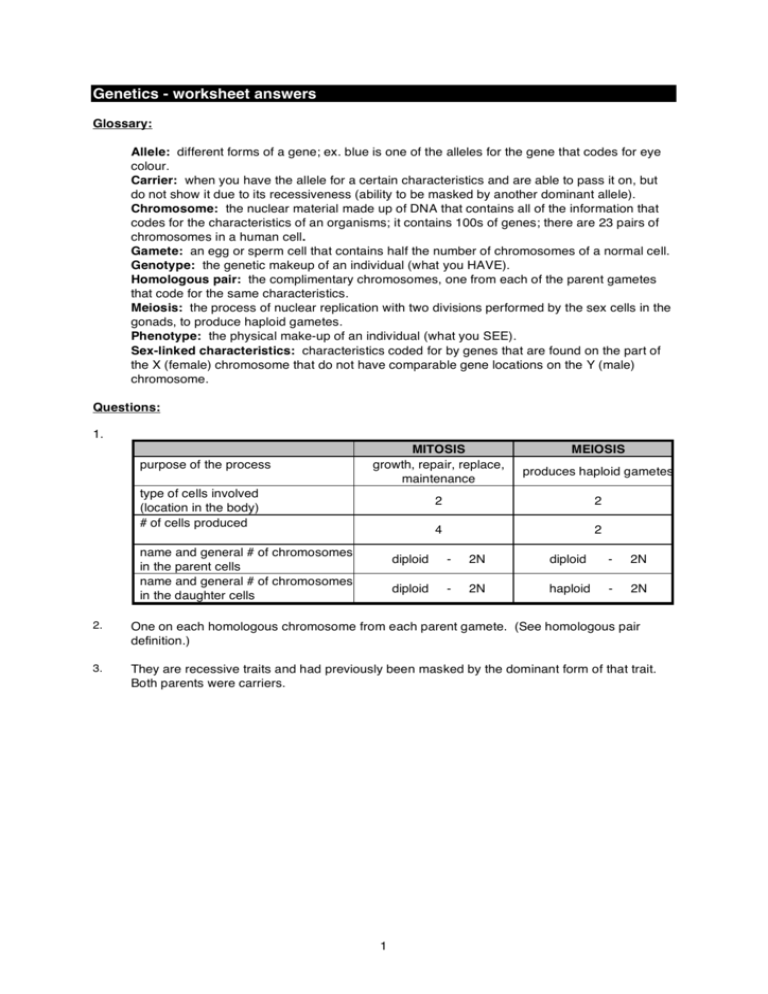
Genetics - worksheet answers Glossary: Allele: different forms of a gene; ex. blue is one of the alleles for the gene that codes for eye colour. Carrier: when you have the allele for a certain characteristics and are able to pass it on, but do not show it due to its recessiveness (ability to be masked by another dominant allele). Chromosome: the nuclear material made up of DNA that contains all of the information that codes for the characteristics of an organisms; it contains 100s of genes; there are 23 pairs of chromosomes in a human cell. Gamete: an egg or sperm cell that contains half the number of chromosomes of a normal cell. Genotype: the genetic makeup of an individual (what you HAVE). Homologous pair: the complimentary chromosomes, one from each of the parent gametes that code for the same characteristics. Meiosis: the process of nuclear replication with two divisions performed by the sex cells in the gonads, to produce haploid gametes. Phenotype: the physical make-up of an individual (what you SEE). Sex-linked characteristics: characteristics coded for by genes that are found on the part of the X (female) chromosome that do not have comparable gene locations on the Y (male) chromosome. Questions: 1. purpose of the process MITOSIS growth, repair, replace, maintenance type of cells involved (location in the body) # of cells produced name and general # of chromosomes in the parent cells name and general # of chromosomes in the daughter cells MEIOSIS produces haploid gametes 2 2 4 2 diploid - 2N diploid - 2N diploid - 2N haploid - 2N 2. One on each homologous chromosome from each parent gamete. (See homologous pair definition.) 3. They are recessive traits and had previously been masked by the dominant form of that trait. Both parents were carriers. 1 4. a) dominant/recessive - there are two forms of the gene and two phenotypes, but only one is ever shown; if the form is shown in either the homozygous (both the same) or the heterozygous (both different) state, then it is dominant; it the form is shown only in the homozygous state (there is no dominant form to mask it), then it is recessive ex. for the trait eye colour: the brown gene (B) is dominant over the blue gene (b) genotype phenotype BB brown Bb brown bb blue b) incomplete dominance - there are two forms of the gene, but there are three possible phenotypes - a new one completely different from the original two; neither one is dominant over the other; the form of the gene is only seen if it is homozygous ex. for the trait flower colour: the white gene (W) is incompletely dominant to the red gene (W'), with the intermediate colour being pink genotype phenotype WW white WW' pink W'W' red c) co-dominance - there are two forms of the gene, and there are three possible phenotypes - one that is a combination of the original two; neither one is dominant over the other; both are shown when it is heterozygous ex. for the trait of human blood type: the A gene is co-dominant with the B gene genotype phenotype AO A AA A BO B BB B AB AB OO O ** NOTE: there are multiple alleles (not just two) for blood type and the third allele is recessive to the other two d) sex-linked - the genes for sex-linked traits are found on the X chromosome and must be shown as such, with a corresponding Y gene as the homologous pair; these traits are usually recessive, which means if they are present in a male then they are shown, and are only shown in a female if they are in the homozygous condition ex. the gene for haemophiliac (a blood disorder): the gene for normal blood (H) is dominant to the gene for haemophilia (h) genotype phenotype XHXH female - normal XHXh female - normal, carrier XhXh female - haemophiliac (rarely found) XHY male - normal XhY male - haemophiliac 2 5. a) genotype TT Tt tt phenotype tall tall short b) t t T Tt Tt T Tt Tt 1. genotype: all heterozygous tall 2. phenotype: all tall c) d) t t • • 6. T Tt Tt t tt tt genotypes: 50% heterozygous tall, 50% (homozygous) short phenotypes: 50% tall, 50% short a) G g G GG Gg g Gg gg g g G Gg Gg g gg gg G g G GG Gg G GG Gg b) c) 7. a) T t Genotype GG Gg gg • • T TT Tt t Tt tt genotypes: 25% homozygous tall; 50% heterozygous tall, 25% (homozygous) short phenotypes: 75% tall, 25% short There was a 25% possibility of a black-bodied fly and in 5664 flies, there probably should have been at least one; therefore these are not the parent genotypes. There was a 75% possibility of a black-bodied fly and in 5664 flies, there probably should have been at least one; therefore these are not the parent genotypes. There was no possibility of a black-bodied fly and in 5664 flies there wasn't any; therefore these are one possibility of parent genotypes - the other being GG x GG. Phenotype green green yellow i) Genotypic ratio (GG:Gg:gg) is 0:4:0 g g G Gg Gg G Gg Gg Phenotypic ratio (green: yellow) is 4:0 NOTE: ratios can and should be reduced to 0:1:0 and 1:0. All subsequent ratios will be reduced where possible ii) Genotypic ratio (GG:Gg:gg) is 1:2:1 g g G Gg Gg G Gg Gg Phenotypic ratio (green: yellow) is 3:1 3 8. a) Genotype RR Rr rr Phenotype red red white i) Genotypic ratio (RR:Rr:rr) is 1:1:0 R r R RR Rr R RR Rr r r R Rr Rr r rr rr Phenotypic ratio (red: white) is 1:0 ii) Genotypic ratio (RR:Rr:rr) is 0:1:1 Phenotypic ratio (red: white) is 1:1 9. a) b) Homozygous tasters (PP) and non-tasters: 100% - all children will be Pp (tasters) Both heterozygous tasters: 75% - it will be a 3:1 ratio of tasters (PP and Pp) to nontasters (pp) 10. a) This is incomplete dominance, as there are three different phenotypes and only two alleles. Since neither allele is dominant over the other, both must be the same kind of letter (upper case); and since they refer to the same characteristic they must be the same letter; therefore to distinguish between them you must put a 'prime' beside one of them. Genotype Phenotype RR Red RRʼ Pink RʼRʼ White b) c) d) Red and pink R Rʼ R RR RRʼ Both pink R RR RRʼ R Rʼ 50% red and 50% pink 11. a) b) c) 12. a) b) R RR RRʼ 25% red, 50% pink and 25% white This is a co-dominance. Since neither allele is dominant over the other they both must be the same kind (upper case). i) Red cattle and white cattle are crossed. - 100% roan cattle (RW) ii) Two roan cattle are crossed. - 1:2:1 (red:roan:white) Sex-linked inheritance i) XHXh -female, normal blood-clotting (carrier) ii) XHY - male, normal-clotting iii) XhXh - female, haemophiliac iv) XhY - male, haemophiliac c) Rʼ RRʼ RʼRʼ v) XHXH - female, normal blood-clotting 1. XHY 2. XHXh 3. XhY 4. XHY 4 5. XHXh 6. XhY 13. Since they have an AB child, the parents had to have had the A and B alleles to be able to pass them on; and since they have an O child, genotype OO, the parents each had to have had the O allele to be able to pass it on; therefore, the genotypes of the parents were AO and BO. A AB AO B O 5 O BO OO




